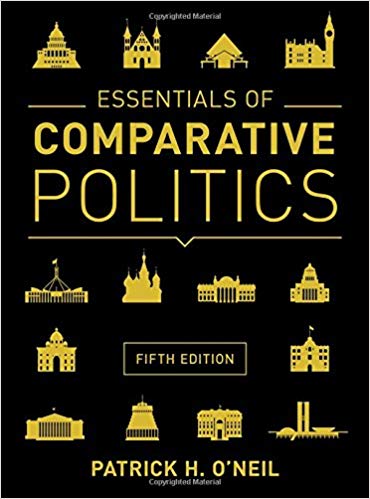Test Bank for Essentials of Comparative Politics 5th by O’Neil
$35.00 Original price was: $35.00.$26.50Current price is: $26.50.
Test Bank for Essentials of Comparative Politics 5th by O’Neil
Test Bank for Essentials of Comparative Politics 5th by O’Neil

Product details:
- ISBN-10 : 9780393938975
- ISBN-13 : 978-0393938975
- Author: Patrick H. O’Neil
The Essentials of Comparative Politics family provides all of the tools professors need to introduce the study and comparison of political systems. A brief conceptual textbook of the core ideas behind comparative politics, a complete casebook of thirteen country studies, and a comprehensive reader of secondary and primary sources―together these give instructors the utmost flexibility in structuring their courses without asking students to pay too much.
Table contents:
1 Introduction 2
What Is Comparative Politics? 6
The Comparative Method 7
Can We Make a Science of Comparative Politics? 12
A Guiding Concept: Political Institutions 19
A Guiding Ideal: Reconciling Freedom and Equality 22
Institutions in Action: Can We Make a Science of Politics? 24
In Sum: Looking Ahead and Thinking Carefully 26
2 States 30
Defining the State 33
The Origins of Political Organization 38
The Rise of the Modern State 41
Comparing State Power 46
Legitimacy 46
Centralization or Decentralization 50
Power, Autonomy, and Capacity 51
Institutions in Action: Why has Pakistan Slid Toward State Failure? 56
In Sum: Studying States 58
3 Nations and Society 62
Ethnic Identity 66
National Identity 68
Citizenship and Patriotism 70
Ethnic Identity, National Identity, and Citizenship: Origins and Persistence 72
Ethnic and National Conflict 74
Political Attitudes and Political Ideology 77
Political Attitudes 77
Institutions in Action: How has India Held Together? 78
Political Ideology 83
Religion, Fundamentalism, and the Crisis of Ideology 88
Political Culture 91
In Sum: Society and Politics 95
4 Political Economy 98
The Components of Political Economy 102
Markets and Property 102
Public Goods 104
Social Expenditures: Who Benefits? 105
Taxation 106
Money, Inflation, and Economic Growth 107
Regulation 110
Trade 111
Political-Economic Systems 112
Liberalism 112
Social Democracy 114
Communism 116
Mercantilism 118
Political-Economic Systems and the State:
Comparing Outcomes 120
Measuring Wealth 121
Measuring Inequality and Poverty 122
Human Development Index (HDI) 124
Happiness 126
The Rise and Fall of Liberalism? 128
In Sum: A New Economic Era? 131
Institutions in Action: Why Have Poverty and Inequality Declined in Latin America? 132
5 Democratic Regimes 136
Defining Democracy 140
Origins of Democracy 141
Contemporary Democratization 143
Modernization and Democratization 143
Elites and Democratization 145
Society and Democratization 146
International Relations and Democratization 147
Culture and Democratization 147
Institutions of the Democratic State 148
Executives: Head of State and Head of Government 148
Legislatures: Unicameral and Bicameral 149
Judiciaries and Judicial Review 150
Models of Democracy: Parliamentary, Presidential, and Semi-Presidential Systems 152
Parliamentary Systems 152
Presidential Systems 154
Semi-Presidential Systems 155
Parliamentary, Presidential, and Semi-Presidential Systems: Benefits and Drawbacks 156
Political Parties 158
Electoral Systems 159
Referendum and Initiative 167
Civil Rights and Civil Liberties 168
In Sum: Future Challenges to Democracy 169
Institutions in Action: What Explains Democratization in Asia? 170
6 Nondemocratic Regimes 174
Totalitarianism and Nondemocratic Rule 179
Origins and Sources of Nondemocratic Rule 181
Modernization and Nondemocratic Rule 181
Elites and Nondemocratic Rule 182
Society and Nondemocratic Rule 183
International Relations and Nondemocratic Rule 184
Culture and Nondemocratic Rule 185
Nondemocratic Regimes and Political Control 187
Coercion and Surveillance 188
Co-optation: Corporatism and Clientelism 189
Personality Cults 192
Models of Nondemocratic Rule 193
Personal and Monarchical Rule 194
Military Rule 195
One-Party Rule 196
Theocracy 197
Illiberal and Hybrid Regimes 199
Institutions in Action: What Explains the Different Paths of Zimbabwe and South Africa? 200
In Sum: Retreat or Retrenchment for Nondemocratic Regimes? 202
7 Political Violence 206
What Is Political Violence? 209
Why Political Violence? 210
Institutional Explanations 210
Ideational Explanations 211
Individual Explanations 212
Comparing Explanations of Political Violence 213
Forms of Political Violence 214
Revolution 214
Terrorism 219
Institutions in Action: Why Did the “Arab Spring” of 2011 Occur? 220
Terrorism and Revolution: Means and Ends 226
Political Violence in Context: Faith, Terrorism, and Revolution 228
Countering Political Violence 232
In Sum: Meeting the Challenge of Political Violence 235
8 Developed Democracies 238
Defining Developed Democracy 242
Freedom and Equality in Developed Democracies 246
Developed Democracies Today 248
Political Institutions: Sovereignty Transformed? 250
The European Union: integration, Expansion, and Resistance 250
Institutions in Action: What Explains the Greek Economic Crisis? 256
Devolution and Democracy 258
Societal Institutions: New Identities in Formation? 260
Postmodern Values and Organization 260
Diversity, Identity and the Challenge to Postmodern Values 262
Economic Institutions: A New Market? 264
Postindustrialism 264
Maintaining the Welfare State 266
In Sum: The Developed Democracies in Transition 268
9 Communism and Postcommunism 270
Communism, Equality, and the Nature of Human Relations 274
Revolution and the “Triumph” of Communism 276
Putting Communism into Practice 278
Communist Political Economy 282
Societal Institutions under Communism 284
The Collapse of Communism 286
The Transformation of Political Institutions 289
Reorganizing the State and Constructing a Democratic Regime 290
Evaluating Political Transitions 290
The Transformation of Economic Institutions 295
Privatization and Marketization 295
Evaluating Economic Transitions 297
The Transformation of Societal Institutions 299
Re-creating Identities 300
Evaluating Societal Transitions 301
In Sum: The Legacy of Communism 303
Institutions in Action: Why Did Reform Fail in the Soviet Union But Succeed in China? 304
10 Developing Countries 308
Freedom and Equality in the Developing World 312
Imperialism and Colonialism 313
Institutions of Imperialism 317
Exporting the State 317
Sociol Identities 318
Dependent Development 320
The Challenges of Post-Imperialism 322
Building State Capacity and Autonomy 323
Generating Economic Growth 328
Puzzles and Prospects for Democracy and Development 330
Forging States 332
Budding Society 334
Promoting Economic Prosperity 336
Institutions in Action: Why Did Asia Industrialize Faster than Latin America? 338
In Sum: The Challenges of Development 340
11 Globalization and the Future of Comparative Politics 342
What Is Globalization? 346
Institutions and Globalization 348
Political Globalization 350
Economic Globalization 353
Societal Globalization 357
Taking Stock of Globalization 361
Is Globalization New? 361
Is Globalization Exaggerated? 363
Is Globalization Inevitable? 366
Institutions in Action: Did Globalization Cause the recent Economic Recession? 368
In Sum: The Future of Freedom and Equality 370
Notes A-1
Glossary A-15
Credits A-25
Index A-27
Related products
Test Bank
Test Bank for Operating Systems: Internals and Design Principles, 7th Edition: William Stallings











